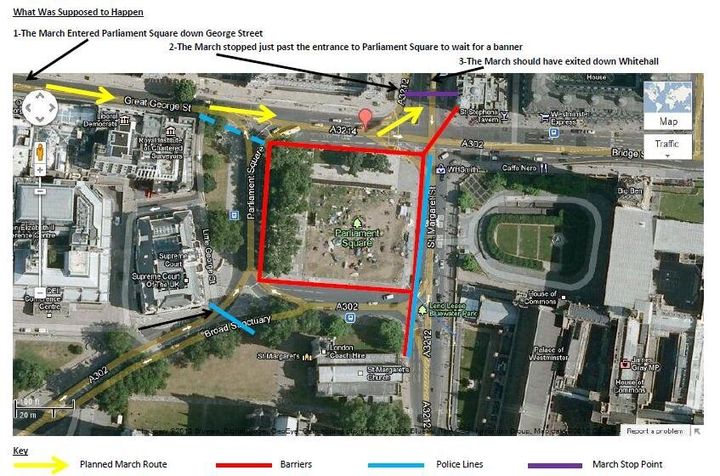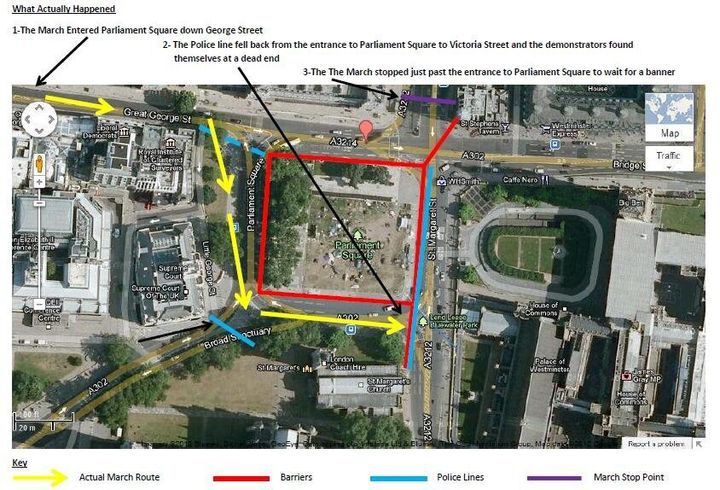Look out London: the students are coming. Again. And if police and press reports of the last major student demonstration, back in 2010, are to be believed, a torrid time is on its way.
But should we? Believe, that is, the sensationalist one-sided version we have been fed in the two years since? Or is it possible that events on the day - 9 December 2010 - were not quite the absolute Manichaean struggle between Good (Police) and Evil (students), claimed loudly by some politicians, some commentators.
Is it possible that the real story includes a dash of cock-up on both sides. Or that senior police and establishment figures, rather than own to their failings, would rather demonise many who were no more than innocent victims of an afternoon of chaos?
A good start
Let's start with expectations. Following clashes between students and police throughout Autumn 2010, these included a heady mix of optimism and concern. Ominously, The Met's superintendent Julia Pendry is quoted in contemporary Guardian coverage of the day warning beforehand that: " there is evidence to suggest a number of people will come to London intent on causing violence and disorder."
Still, the early stages were good natured, with an estimated 40,000 student protesters expected. At 2.08 pm, again according to the Guardian narrative, the atmosphere remained "for the most part, good-natured if slightly chaotic".
At 3.10pm, after the protest had swamped Parliament Square, police officers were still telling students that they were free to leave.
By 3.45pm, the mood had changed utterly. Those in Parliament Square had been kettled, according to police "because of the level of violence directed at police officers". Mounted police had charged into the crowd. It was a case, as the prophets of doom had expected all along, of "rioting as usual". What went wrong?

The march (see diagram 1) was originally supposed to come down Great George Street, down the side of Parliament Square and turn left into Whitehall.
Chaotic continuation
In the event, it stopped a little way down Whitehall. Many students believed the police had stopped them but in a letter to the Chair of the Human Rights Joint Committee, assistant commissioner Allinson states that the march stopped because those at the front were waiting for a banner to arrive. Police asked stewards to "restart the march" to prevent harm being caused to people in the crowd. However, Allinson continues, the organisers were "uncooperative".
What followed was fairly predictable. As the march stood still - for over 20 minutes - crowd pressure began to build. Students present wrongly assumed this to be the start of some form of police containment or 'kettle', used on previous occasions, according to point of view, to maintain public order, or to punish demonstrators. Temperatures were rising, and at this point, the police decided to give the students Parliament Square.

The police line blocking entry into Parliament Square wheeled back (diagram 2) allowing students access. This move was not, as several media reported at the time, because demonstrators had gone off route, but because the police had taken the wholly sensible decision to make use of a pre-designated 'pressure relief' area to avoid a crush situation. According to observers at a later trial, a superintendent Woods gave evidence stated that if the students had not followed the police into the Square "they would have been made to".
Still, to an outsider, subsequent events may have appeared rather more alarming than they actually were. As students poured into Parliament Square (at around 2.37pm), they pulled down the barriers blocking off the central grassy area. Vandalism? Or actually quite sensible. A few students started to make bonfires to keep warm, setting fire to their placards.
Meanwhile the Met's Silver Command (providing overall direction to officers on the ground) had cordoned off all exits from Parliament Square except into Whitehall. In theory, marchers wishing to continue must now parade round three sides of the square before exiting. In practice, this merely added to the confusion and raised the temperature further, as those trying to get out of the square were passed from one cordon to another, with no clear understanding of why.
Police on the front line did not appear to know what was happening, either. Matters were not helped by the fact, revealed by video footage, that Silver was, at times, having to rely on contacting Bronze commanders by mobile phones as they could not be reached by radio.
Ending in tears
Footage also suggests that the level of violence on both sides was now escalating, with police officers using their batons against individual demonstrators and some demonstrators, in turn, retaliating.
Still, between 3pm and 3.10pm at least one police officer stationed behind the police lines in front of Parliament Square is telling the protesters, via megaphone, that this "is not a containment" and "if you wish to leave, leave by the rear".
Unfortunately, as later accepted by superintendent Woods, 'the rear' would suggest to most students that they should leave via Broad Sanctuary/Victoria Street. He also stated that if the students were being sent in that direction, it should be a "filter cordon" as marchers should never be directed to a full cordon.
However, a second officer, inspector Donaldson, giving evidence at the same trial, confirmed that the cordon in place across Broad Sanctuary/Victoria Street was a full one and added that he'd be very surprised if any officer was sending the marchers to his line.
It is clear from video footage that those in the square turn rapidly toward Broad Sanctuary, at the time blocked by a single police line. The police quickly pull the line back and reinforce it: as they do so, students follow apparently believing that, as happened in Great George St, they are being lead out of Parliament Square. This appears to be the critical misunderstanding that turned a demonstration that until that point had been mostly peaceful into a major incident.
From the police perspective the marchers were attacking their line and putting it under severe pressure. From the marcher's perspective they were simply doing what they have been told to do. At 3.23pm the order was given to implement a complete containment of Parliament Square: minutes later, mounted officers charged into the crowd in Broad Sanctuary further inflaming the situation. What followed is now tabloid history.
Questions to answer
Still, this raises real questions, not just about the alleged 'badness' of the demonstrators, but also about police tactics on the day. The first is summed up in a series of iconic images, not least of which is that of a police officer being dragged along the ground after allegedly being pulled from his horse by students. We know this because the next day the prime minister, David Cameron, spoke publically to condemn such outrageous behaviour.
Scarcely mentioned in the press is the trial verdict some 18 months later, clearing the alleged villains and placing the blame for the officer's downfall squarely on his own shoulders. Sadly, neither the PM nor his press office felt moved to make any public apology for earlier remarks.
Meanwhile, there are further questions to be asked: about police communication on the day; and whether 'containing' large numbers of people in one area and then charging horses into the resulting crowd is really the best way to defuse a situation?
Over all, though, the central question is whether the police have learnt anything or whether they are prepared to concede in the least that they have anything to learn or whether, as happened at Hillsborough, it is considered sufficient to blame those on the receiving end and, publically at least, to refuse to acknowledge that anything the Met did was in any way other than 100% perfect?
Note: the key points above have been put to the Met Police, who, when contacted 20 November. declined to comment at this time because "the circumstances of 9th December remain the subject of court proceedings". They added: "We do have a proportionate policing plan in place for tomorrow"